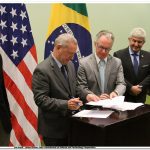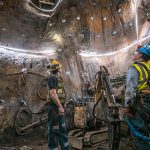From March 6, 2020: Durante a 5ª Comista, os dois países adotaram um Plano de Trabalho em Ciência e Tecnologia para o período de 2020 a 2023, que estabelece as prioridades comuns descritas acima. Também foram firmados acordos de cooperação na área de cooperação científica em Física de Partículas de Alta Energia entre o Fermilab (Laboratório de pesquisa científica do Departamento de Energia dos EUA) e a FAPESP e outro acordo na mesma área entre o Fermilab e a UNICAMP.
Deep Underground Neutrino Experiment
From the Brazil Ministry of Science, Technology, Innovation and Communication, March 6, 2020: Comissão mista entre os dois países possui grupos de trabalho para pesquisas sobre temas como saúde, espaço, tecnologias e agências de financiamentos.
From Brazilian Space, March 10, 2020: Durante a 5ª Comista, os dois países adotaram um Plano de Trabalho em Ciência e Tecnologia para o período de 2020 a 2023. Também foram firmados acordos de cooperação na área de cooperação científica em Física de Partículas de Alta Energia entre o Fermilab e a Fundação de Amparo à Pesquisa do Estado de São Paulo e outro acordo na mesma área entre o Fermilab e a Universidade de Campinas.
From the U.S. Embassy and Consulates in Brazil, March 6, 2020: On March 5-6, Brazil and the United States held the fifth meeting of the Brazil-U.S. Joint Commission on Science and Technology Cooperation in Brasilia to deepen collaboration in key priority areas for the benefit of both countries. FAPESP and Fermilab signed an MOU to deepen scientific and technical cooperation in high-energy physics, and UNICAMP and Fermilab signed a cooperative agreement for a state-of-the-art LBNF cryogenics system.
From News at South Dakota State, Feb. 25, 2020: Two South Dakota State University professors are part of an international team of scientists and engineers working to uncover details about how the universe was formed. Stephen Gent and Greg Michna are using SDSU’s high-performance computing cluster to predict how argon circulates within the particle detectors to be constructed one mile beneath the earth’s surface. The detectors are for Fermilab’s Long-Baseline Neutrino Facility/Deep Underground Neutrino Experiment, which will be installed in the Sanford Underground Research Facility in Lead, South Dakota.
From Tunnels and Tunneling, Feb. 19, 2020: Three of the underground construction components are near completion at the Sanford Underground Research Facility for the far site of Fermilab’s Long-Baseline Neutrino Facility. Work is finishing up on two ore passes that connect the 4850 Level, almost one mile underground, to skips in the Ross Shaft; the Ross Headframe, which must support the skips that bring the rock to the surface; and the tramway tunnel, which will house the conveyor system that will transport excavated rock to its final location.
From Black Hills Pioneer, Feb. 19, 2020: Data from the Deep Underground Neutrino Experiment could help physicists explain the origin of matter, witness a never-before-seen particle decay and better understand how black holes form in space. To prepare for this groundbreaking science, a major construction project is under way to ready the Sanford Underground Research Facility for its role as the far site of Fermilab’s Long-Baseline Neutrino Facility.
From Labmate, Feb. 19, 2020: UK Research and Innovation representatives and the U.S. Department of Energy have signed an agreement outlining £65 million in contributions by UK research institutions and scientists to the international Deep Underground Neutrino Experiment and related projects hosted by Fermilab.


